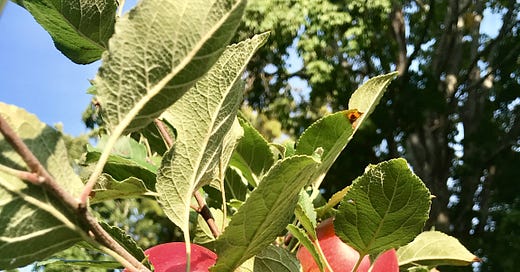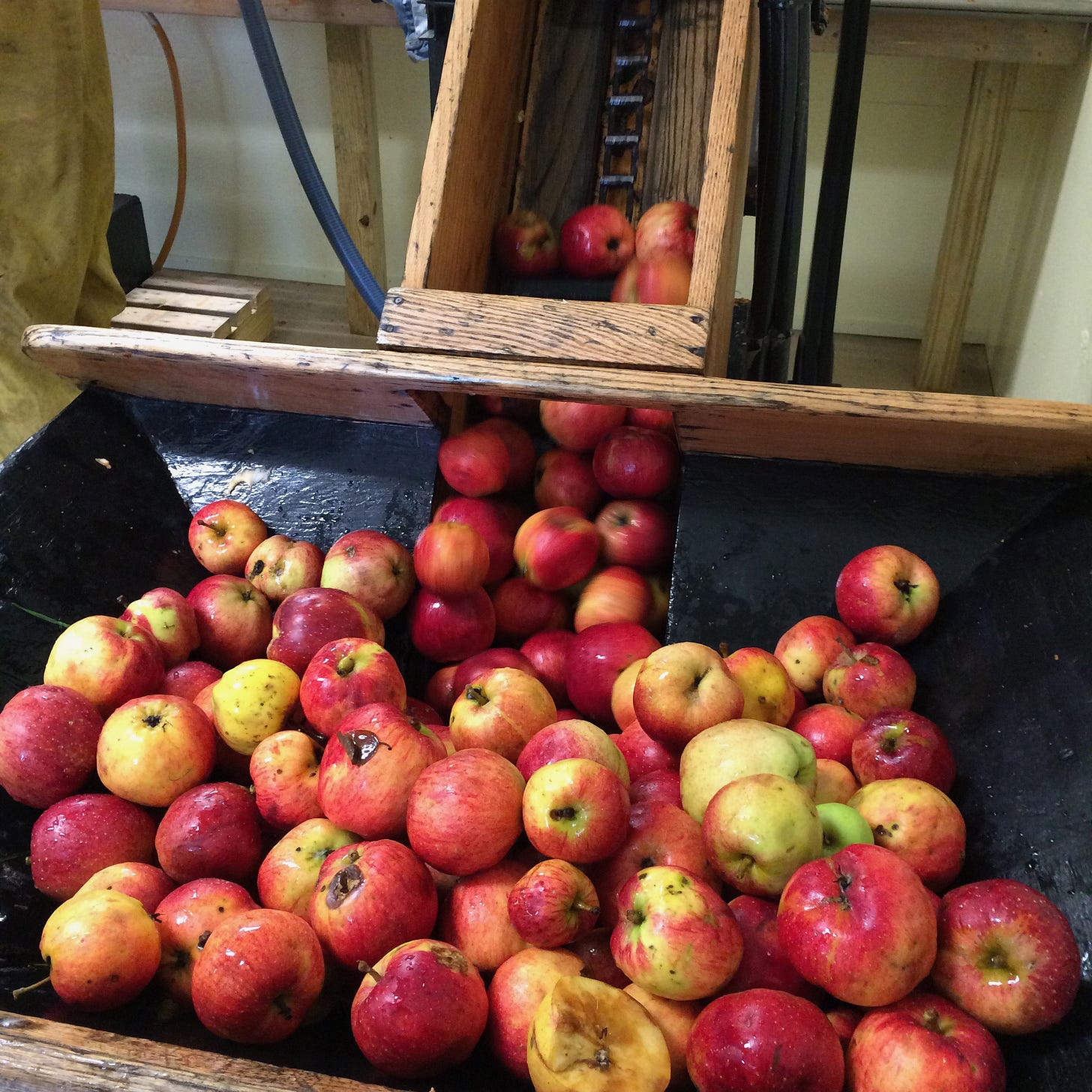I planted two apple trees outside the door of a house I once owned in Somerville, Massachusetts. The house sat almost at the top of Prospect Hill, where General Israel Putnam was rumored to have told his troops, “Don’t shoot, boys, till you see the whites of their Redcoat eyes.” But that may have been mythology.
The apples I planted were an Esopus Spitzenburg, said to have been Thomas Jefferson’s favorite apple, and a Roxbury Russet which may have been the first named apple to be developed in North America.
I love apples and I love apple trees. I grew up with a small orchard that my father owned on the coast of Maine where he had, it seemed, one each of a variety of apples that are almost impossible to find these days—Wealthies and Wolf Rivers, very early Yellow Transparents, adored Gravensteins, something called Winter Banana which really did taste and smell like a banana, besides the usual Macintosh and Cortlands, plus a couple of pear trees and a very tall and unusually heavy-bearing crab apple, the only apple apparently that is native to this continent.
Apples are not natives here, though you might think so in May in New England when the orchards are in blossom and the bees are frantic with glee, or in October when mile after mile of country roads yields the sight of old abandoned apples, still faithfully producing their handsome fruits, gold and crimson in the autumn sunshine. It’s Kazakhstan, actually, far off in Central Asia, where apples originate. I always hoped one day to see the wild apple orchards of Kazakhstan but I’m sorry to say that if I do, it will likely be in my dreams!
On a cold, gray day in February some years ago, I ventured into the North Woods of Maine on a quest for an old logging camp. This was an adventure beyond apples, beyond Kazakhstan, and something I probably would not contemplate doing today. I drove three hours under lowering skies to Greenville on the shores of Moosehead Lake, then proceeded along the eastern side of the big lake till I found a logging track that would lead me, I was assured, to Township A, Range 12, and a cluster of cabins called West Branch Pond Camps. Mind you, this was so long ago, if you can remember such a world, that we had no GPS systems. I was going on blind instinct and a few bits of information picked up in Greenville. Ten miles down that road I would find my camp ground. My cell phone, of course, had lost its tenuous connection with reality some time earlier.
When I say a logging track—it was indeed an identifiable road, unpaved but wide and properly graded, cut through dense forest to accommodate logging trucks over-laden with plunder from the woods of Maine. Because it was winter, the road was covered in deeply packed snow with no turn-outs and no assurance that there wouldn’t be a giant behemoth lumbering toward me with a tower of logs.
I repeat, I would NEVER do that all by myself today. But back then, it’s fair to say I was more adventurous, more cavalier about hazards, more indifferent to risks. And after all, what could happen to me really? Hmm, at worst I could spend a night in the woods, hoping one of those logging trucks would spot me and pull me out of a snow drift. Or not.
A radiant fire in the wood stove, a pile of quilts on the high bed, a stack of logs to keep me warm throughout the night. . . .
In the event, it was unnecessary. Because after a while I turned off the logging road and into a cluster of cabins where Eric Stirling and his then girlfriend, now wife, Mildred kept the home fires burning. Literally, in my case. The cabin I was assigned was bare wood, uninsulated, but with a radiant fire in the wood stove, a pile of quilts on the high, four-poster bed, and a stack of logs to keep me warm throughout the night.
I had arrived along with a party of eight dog sledders and 24 Yukon huskies, coming from the other direction on a five-day winter trek through the Maine woods. Sledders and dogs alike, they were all very hungry. So was I. And to the point, in the main cabin where we gathered, there was an abundance of food—an old-fashioned beef pot roast, such as my grandmothers used to make, a stout piece of chuck, well marbled with fat, brought to a simmer in a black iron kettle, with nothing but a little water, salt and pepper, then baked in the oven for three or four hours until it was fork-tender. The requisite vegetables (carrots, onions, potatoes, plus cabbage for who wanted it) were added toward the end, and then the flavors were boosted with a final addition of a couple spoons of Gravy Master, a dark, thick, potent seasoning liquid. “A good old logging camp special,” said Eric, who was acting chef for the evening.
So why, on a sunny day in October, am I writing about something that happened long ago in the cold Maine woods in February? Because what followed Eric’s pot roast was even more special—his mother’s apple pie.
Please consider joining On the Kitchen Porch as a paid subscriber so you can read the rest of this post, with Carol’s recipe for apple pie.
Keep reading with a 7-day free trial
Subscribe to On the Kitchen Porch to keep reading this post and get 7 days of free access to the full post archives.






